The Radiometric Detectors Market is estimated to be valued at USD 3.6 billion in 2025 and is projected to reach USD 7.0 billion by 2035, registering a compound annual growth rate (CAGR) of 6.7% over the forecast period.
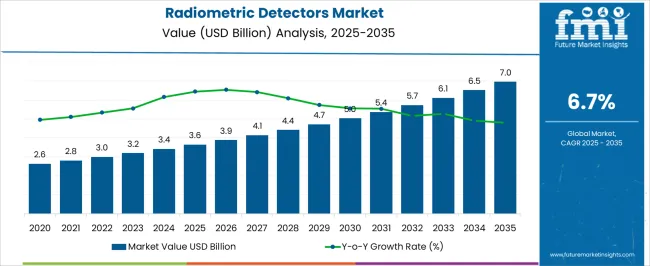
| Metric | Value |
|---|---|
| Radiometric Detectors Market Estimated Value in (2025 E) | USD 3.6 billion |
| Radiometric Detectors Market Forecast Value in (2035 F) | USD 7.0 billion |
| Forecast CAGR (2025 to 2035) | 6.7% |
The Radiometric Detectors market is experiencing consistent growth due to the rising adoption of advanced detection technologies in scientific research, industrial monitoring, and healthcare applications. The market is being driven by the need for precise measurement of radiation levels, rapid data acquisition, and reliable performance across diverse operational environments. Increasing investments in biotechnology and pharmaceutical research, along with the demand for high-sensitivity detection in laboratory and industrial settings, are shaping the market trajectory.
Technological advancements, including enhanced semiconductor materials, compact detector designs, and integration with automated data systems, are facilitating broader application of radiometric detection solutions. The growing focus on safety compliance and regulatory monitoring has also accelerated demand, particularly in research institutes and industrial facilities.
Future opportunities are expected in integrating these detectors with IoT-enabled monitoring systems and analytical software platforms, which allow remote management, real-time alerts, and improved operational efficiency As industries increasingly emphasize precision, safety, and data-driven decision-making, radiometric detectors are expected to play a critical role in maintaining standards and supporting advanced scientific research.
The radiometric detectors market is segmented by product type, application, end users, and geographic regions. By product type, radiometric detectors market is divided into Semiconductor Detectors, Gas Ionization Detectors, Solid Scintillators, Liquid Scintillators, Geiger Counter Radiometric Detectors, Magnetic Spectrometers, and Cerenkov Detectors. In terms of application, radiometric detectors market is classified into Proximity Detection, RGB Color Sensing, Gesture Recognition, Light Sensing, and UB/IR Detection. Based on end users, radiometric detectors market is segmented into Biotechnology And Pharmaceutical Institutes, Diagnostic Laboratories, and Research Institutes. Regionally, the radiometric detectors industry is classified into North America, Latin America, Western Europe, Eastern Europe, Balkan & Baltic Countries, Russia & Belarus, Central Asia, East Asia, South Asia & Pacific, and the Middle East & Africa.
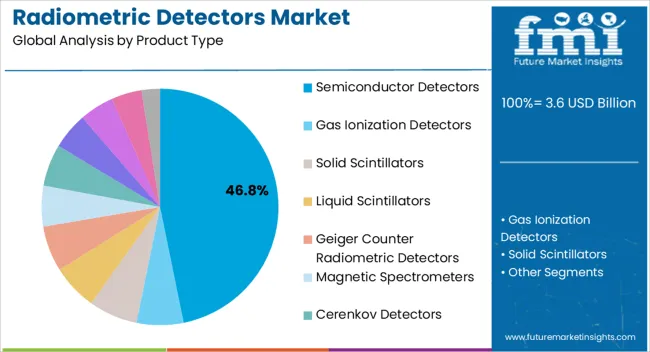
The semiconductor detectors segment is projected to hold 46.80% of the Radiometric Detectors market revenue in 2025, positioning it as the leading product type. This dominance is being attributed to the high sensitivity, rapid response time, and compact design offered by semiconductor-based technologies, which allow precise measurement of low-intensity radiation. Semiconductor detectors have been widely adopted in laboratory research, industrial quality control, and safety monitoring applications, where accuracy and reliability are critical.
The ability to integrate these detectors with digital data acquisition systems and automated monitoring platforms has further increased their value proposition. Growth is also supported by advancements in material science and microfabrication techniques, which have improved detector efficiency and reduced operational costs.
Additionally, the scalability and modularity of semiconductor detectors have facilitated their deployment across multiple end-use environments without extensive modifications As demand for highly precise and real-time radiation detection grows, semiconductor detectors are expected to maintain a leading position in the market.
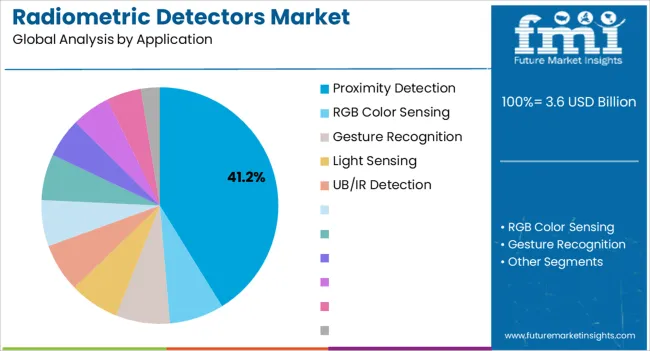
The proximity detection application segment is anticipated to account for 41.20% of the Radiometric Detectors market revenue in 2025, establishing it as the most prominent application area. This leading position is being driven by the need for accurate, real-time detection of radiation presence in sensitive environments such as laboratories, cleanrooms, and industrial process monitoring.
Proximity detection is favored due to its ability to deliver immediate alerts for radiation exposure, thereby supporting safety compliance and operational efficiency. The adoption has been accelerated by the integration of these detectors with automated control systems and monitoring software, which allow remote management and rapid response to potential hazards.
Technological enhancements, including improved sensor resolution and signal processing algorithms, have further strengthened the segment’s market share As the demand for workplace safety, regulatory compliance, and precise monitoring continues to grow, proximity detection applications are expected to remain a key driver of radiometric detector adoption.
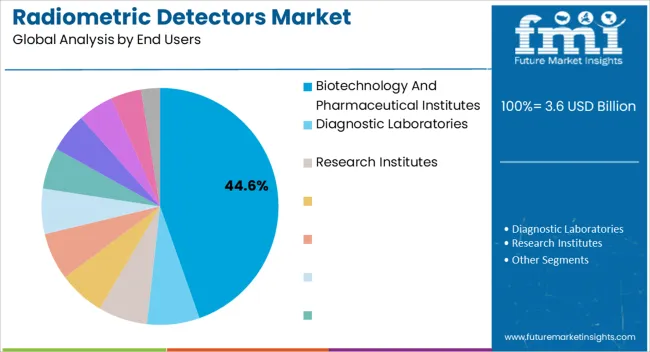
The biotechnology and pharmaceutical institutes end-use industry segment is projected to hold 44.60% of the Radiometric Detectors market revenue in 2025, making it the largest consumer segment. The growth of this segment is being driven by the increasing use of radiometric detection in drug development, genomic research, clinical diagnostics, and quality control processes.
These institutes require highly sensitive, accurate, and reliable detection systems to monitor radioactive tracers, assay results, and contamination levels, which has bolstered demand for advanced radiometric detectors. The segment benefits from the ability to integrate detectors with automated laboratory equipment, enabling high-throughput analysis and minimizing human error.
Additionally, regulatory guidelines and safety protocols in pharmaceutical and biotechnology research have necessitated the adoption of sophisticated detection systems, further supporting market expansion As investment in research activities rises globally and precision in laboratory monitoring becomes increasingly critical, biotechnology and pharmaceutical institutes are expected to continue leading the consumption of radiometric detectors.
This Radiometric Detectors market study offers a comprehensive analysis of the business models, key strategies, and respective market shares of some of the most prominent players in this landscape. Along with an in-depth commentary on the key influencing factors, market statistics in terms of revenues, segment-wise data, region-wise data, and country-wise data are offered in the full study.
This study is one of the most comprehensive documentation that captures all the facets of the evolving Radiometric Detectors market.
Radiometry involve techniques that uses visible light to measure electromagnetic radiations. Contrary to photometric techniques, these techniques characterize the segregation of radiation’s power in space. Radiometry is different from basic quantum techniques like photon counting. Radiometric detectors are used to analyze drug pathways, assess environmental contaminations and protect laboratory environments.
Radiometric detectors are considered to be the gold standard and are extensively used for these applications because of their high specificity and sensitivity to light. Radiometric detectors are designed for precise management of beta counting, gamma counting and related methods.
Other applications that involve radiometric detectors are color processing, transport, spectroscopy, imaging applications in pharmaceutical and chemical industries and other medical communication sectors. Commonly used radiometric detectors produce several changes in their electrical attributes; mainly, voltage, current, temperature, or resistance. It is then measured electrically. Majority of the cases involve the output to be displayed by the detectors, and is then calibrated to analyze the amount of light absorbed by radiometric detectors.
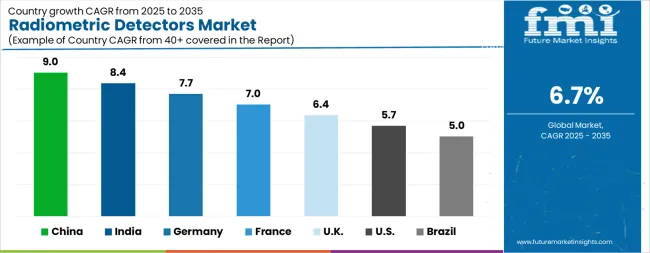
| Country | CAGR |
|---|---|
| China | 9.0% |
| India | 8.4% |
| Germany | 7.7% |
| France | 7.0% |
| UK | 6.4% |
| USA | 5.7% |
| Brazil | 5.0% |
The Radiometric Detectors Market is expected to register a CAGR of 6.7% during the forecast period, exhibiting varied country level momentum. China leads with the highest CAGR of 9.0%, followed by India at 8.4%. Developed markets such as Germany, France, and the UK continue to expand steadily, while the USA is likely to grow at consistent rates. Brazil posts the lowest CAGR at 5.0%, yet still underscores a broadly positive trajectory for the global Radiometric Detectors Market. In 2024, Germany held a dominant revenue in the Western Europe market and is expected to grow with a CAGR of 7.7%. The USA Radiometric Detectors Market is estimated to be valued at USD 1.3 billion in 2025 and is anticipated to reach a valuation of USD 2.3 billion by 2035. Sales are projected to rise at a CAGR of 5.7% over the forecast period between 2025 and 2035. While Japan and South Korea markets are estimated to be valued at USD 188.2 million and USD 112.1 million respectively in 2025.
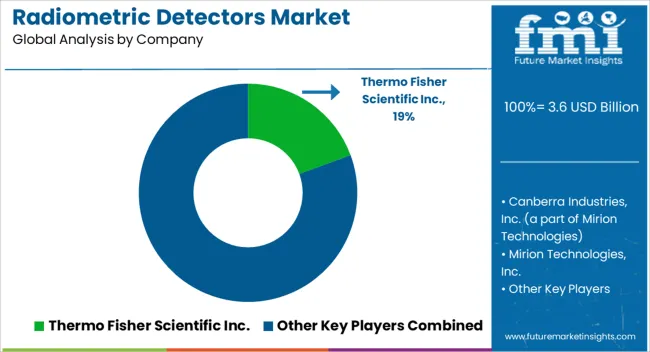
| Item | Value |
|---|---|
| Quantitative Units | USD 3.6 Billion |
| Product Type | Semiconductor Detectors, Gas Ionization Detectors, Solid Scintillators, Liquid Scintillators, Geiger Counter Radiometric Detectors, Magnetic Spectrometers, and Cerenkov Detectors |
| Application | Proximity Detection, RGB Color Sensing, Gesture Recognition, Light Sensing, and UB/IR Detection |
| End Users | Biotechnology And Pharmaceutical Institutes, Diagnostic Laboratories, and Research Institutes |
| Regions Covered | North America, Europe, Asia-Pacific, Latin America, Middle East & Africa |
| Country Covered | United States, Canada, Germany, France, United Kingdom, China, Japan, India, Brazil, South Africa |
| Key Companies Profiled | Thermo Fisher Scientific Inc., Canberra Industries, Inc. (a part of Mirion Technologies), Mirion Technologies, Inc., Ludlum Measurements, Inc., AMETEK, Inc. (including Ortec, SII, and Landauer), Becton, Dickinson and Company (BD), FLIR Systems, Inc., Honeywell International Inc., Berthold Technologies GmbH & Co. KG, and Arrow-Tech, Inc. |
The global radiometric detectors market is estimated to be valued at USD 3.6 billion in 2025.
The market size for the radiometric detectors market is projected to reach USD 7.0 billion by 2035.
The radiometric detectors market is expected to grow at a 6.7% CAGR between 2025 and 2035.
The key product types in radiometric detectors market are semiconductor detectors, gas ionization detectors, solid scintillators, liquid scintillators, geiger counter radiometric detectors, magnetic spectrometers and cerenkov detectors.
In terms of application, proximity detection segment to command 41.2% share in the radiometric detectors market in 2025.
Explore Similar Insights

Thank you!
You will receive an email from our Business Development Manager. Please be sure to check your SPAM/JUNK folder too.
Chat With
MaRIA